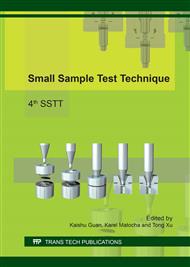[1]
Hyde T. H., Sun W. and Williams J. A. The requirements for and the use of miniature test specimens to provide mechanical and creep properties of materials: - a review. Int. Mater. Rev. 52 (4), 213-255, (2007).
DOI: 10.1179/174328007x160317
Google Scholar
[2]
Hyde T. H., Hyde C. J. and Sun W. A basis for selecting the most appropriate small specimen creep test type. Trans. ASME J. Pre. Ves. Technol. 136 (2), 024502-1- 024502-6. (2014).
DOI: 10.1115/1.4025864
Google Scholar
[3]
Sun W., Hyde T. H. and Brett S. J. Application of impression creep data in life assessment of power plant materials at high temperatures. J. Materials: Design & Applications 222 (3), 175-182, (2008).
DOI: 10.1243/14644207jmda183
Google Scholar
[4]
Sun W. and Hyde T. H. Power plant remaining life assessment using small specimen testing techniques. 9th Annual Conf. on Operational Outages for Power Generation. 28-30 March, 2011, Amsterdam, The Netherlands.
Google Scholar
[5]
Sun W., Hyde T. H. and Brett S. J. Small specimen creep testing and application for power plant component remaining life assessment. 4th Int. Conf. on Integrity, Reliability and Failure. Madeira, 23-27 June, (2013).
Google Scholar
[6]
Hyde T., Sun W., Becker A. A. and Williams J. Creep properties and failure assessment of new and fully repaired P91 pipe welds at 923 K. J. Materials: Design and Applications 218, 211-222, (2004).
DOI: 10.1177/146442070421800305
Google Scholar
[7]
Askins M. C. and Marchant K. D. Estimating the remanent life of boiler pressure parts, EPRI Contract RP2253-1, Part 2, Miniature specimen creep testing in tension. CEGB Report. TPRD/3099/R86, CEGB, UK, (1987).
Google Scholar
[8]
Hyde T. H., Sun W. and Becker A. A. Analysis of the impression creep test method using a rectangular indenter for determining the creep properties in welds. Int. J. Mech. Sci. 38, 1089-1102, (1996).
DOI: 10.1016/0020-7403(95)00112-3
Google Scholar
[9]
Rouse J. P., Cortellino F., Sun W., Hyde T. H., Shingledecker J. Small punch creep testing: a review on modelling and data interpretation. Mater. Sci. Technol. 29 (11), 1328-1345, (2013).
DOI: 10.1179/1743284713y.0000000278
Google Scholar
[10]
Hyde T. H. and Sun W. A novel, high sensitivity, small specimen creep test. J. Strain Analysis 44 (3), 171-185, (2009).
DOI: 10.1243/03093247jsa502
Google Scholar
[11]
Balhassn A., Hyde T. H., Sun W. Analysis and design of a small, two-bar creep test specimen. Trans. ASME J. Eng. Mater. & Technol. 135 (4), 041006-1-041006-9, (2013).
Google Scholar
[12]
Fa-Kun Zhuang, Shan-Tung Tu, Guo-Yan Zhou and Qiong-Qi Wang. Assessment of creep constitutive properties from three-point bending creep test with miniaturized specimens. J. Strain Analysis 46, 1-10, (2014).
DOI: 10.1177/0309324714537056
Google Scholar
[13]
Zheng Y. and Sun W. An inverse approach for determining creep properties from a miniature thin plate specimen under bending. Int. J. Mech., Aerospace, Industrial, Machatronic & Manf. Eng. 9 (7), 1199-1205, (2015).
Google Scholar
[14]
Shan-Tung Tu, Fa-Kun Zhuang, Guo-Yan Zhou, Sun W. Effect of large deformation on the creep properties evaluation by small-specimen bending tests. Int. J. Pres. Ves. & Piping, 139-140, 194-203, (2016).
DOI: 10.1016/j.ijpvp.2016.02.009
Google Scholar
[15]
Fa-Kun Zhuang. Study of small specimen creep test based on the beam bending theory. PhD Thesis. East China University of Science & Technology. (2014).
Google Scholar
[16]
Kachanov L. On rupture time under condition of creep. Izvestia Akademi Nauk USSR, Otd. Techn. Nauk, Moskwa, 8, 26-31, (1958).
Google Scholar
[17]
Lemaitre J. A course on damage mechanics 2nd ed. 1996, Berlin: Springer.
Google Scholar
[18]
Rabotnov Y. N. Creep rupture. 1968. Stanford University: Springer.
Google Scholar
[19]
Hyde T. H., Becker A. A., Sun W. and Williams J. A. Finite element creep damage analyses of P91 pipes. Int. J. Pres. Ves. & Piping 83 (11-12), 853-863, (2006).
DOI: 10.1016/j.ijpvp.2006.08.013
Google Scholar
[20]
Hyde T. H. and Sun W. Determining high temperature properties of weld materials. JSME Int. J. Solid Mechanics & Material Engineering, Series A 43 (4), 408-414, (2000).
DOI: 10.1299/jsmea.43.408
Google Scholar
[21]
Altenbach H., Kolarow G., Morachkovsky O. K. and Naumenko K. On the accuracy of creep-damage predictions in thin walled structures using the finite element method. Computational Mechanics 25, 87-98, (2000).
DOI: 10.1007/s004660050018
Google Scholar
[22]
Altenbach H. and Naumenko K. Shear correction factors in creep damage analysis of beams, plates and shells. JSME Int. Journal, Series A 45 (1), 77-83, (2002).
DOI: 10.1299/jsmea.45.77
Google Scholar


